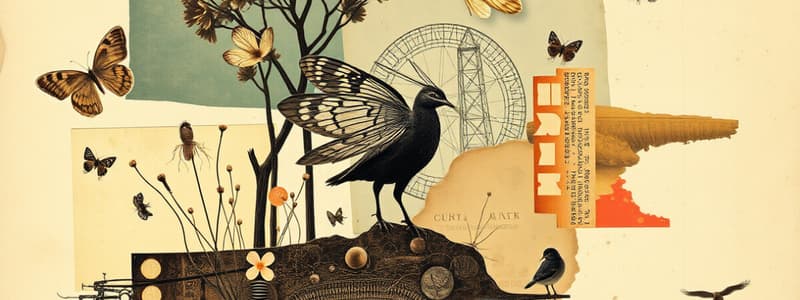Podcast
Questions and Answers
What is an organism's niche?
What is an organism's niche?
Describes an organism's use of resources and functional role in a community.
What is included in an organism's niche?
What is included in an organism's niche?
Where an organism lives, food, when they reproduce, what organisms they interact with.
What is an organism's niche affected by?
What is an organism's niche affected by?
An organism's tolerance—the ability to survive and reproduce under changing environmental conditions.
What restricts an organism's niche?
What restricts an organism's niche?
What is Competitive Exclusion?
What is Competitive Exclusion?
What is an example of Competitive Exclusion?
What is an example of Competitive Exclusion?
What kind of niche can an organism use without competitors?
What kind of niche can an organism use without competitors?
What can happen to an organism's niche if limited by competitors?
What can happen to an organism's niche if limited by competitors?
Why is Resource Partitioning used in a community?
Why is Resource Partitioning used in a community?
What is predation?
What is predation?
What does predation cause?
What does predation cause?
What evolves in an organism in response to predator/prey interactions?
What evolves in an organism in response to predator/prey interactions?
Who has a positive benefit and who has a negative benefit from predation?
Who has a positive benefit and who has a negative benefit from predation?
What is Coevolution of predator/prey?
What is Coevolution of predator/prey?
What is Herbivory?
What is Herbivory?
What kind of defense mechanisms have plants evolved to defend themselves?
What kind of defense mechanisms have plants evolved to defend themselves?
Explain Symbiosis.
Explain Symbiosis.
What is Parasitism?
What is Parasitism?
Who has a positive benefit and who has a negative benefit from parasitism?
Who has a positive benefit and who has a negative benefit from parasitism?
What is Mutualism?
What is Mutualism?
What is an example of Mutualism?
What is an example of Mutualism?
Who benefits from Mutualism?
Who benefits from Mutualism?
What is Commensalism?
What is Commensalism?
Flashcards are hidden until you start studying
Study Notes
Organism's Niche
- An organism's niche encompasses its resource utilization and functional role within a community.
- Key aspects of a niche include habitat, food sources, reproductive periods, and interactions with other organisms.
- The tolerance of an organism influences its niche, determining survival and reproduction abilities in varying environments.
- Competition, both intraspecific (within species) and interspecific (between species), often limits an organism's niche.
Competitive Exclusion
- Competitive exclusion occurs when one species entirely denies another species access to a resource.
- An example includes zebra mussels outcompeting native bivalve species, leading to their starvation or suffocation.
- In the absence of competitors, an organism can fully utilize its fundamental niche.
- Competition can reduce an organism to a realized niche, restricting its access to resources.
Resource Partitioning
- Resource partitioning helps reduce competition by dividing resources among species, potentially resulting in character displacement, where species adopt specialized roles.
Predation
- Predation involves a predator hunting, killing, and consuming its prey.
- This process creates cyclical population dynamics between predators and prey.
- Defensive adaptations in prey species include camouflage, mimicry, and warning coloration, evolving in direct response to predation pressures.
- Predators benefit from predation as a food source, while prey experience negative consequences, often leading to death.
Coevolution
- Coevolution describes the mutual evolutionary influences between predator and prey species, such as Newts developing toxins and Garter snakes evolving tougher skin to survive.
Herbivory
- Herbivory is defined as the consumption of plants by animals, leading to evolutionary pressures on plant defenses.
Plant Defense Mechanisms
- Plants have developed various defensive strategies, including toxic chemicals, distastefulness, thorns, and spines to deter herbivores.
Symbiosis
- Symbiosis signifies a long-term, close relationship where at least one organism benefits from the interaction.
Types of Symbiotic Relationships
- Parasitism: One organism (the parasite) derives benefit at the expense of another (the host), causing harm to the host while the parasite benefits.
- Mutualism: A symbiotic relationship where both species involved reap benefits, exemplified by lichen, which consists of a fungus and a photosynthetic algae.
- Commensalism: A relationship where one species benefits while the other remains unaffected, such as a fish benefiting from residing near a sea anemone.
Benefits in Symbiotic Relationships
- In parasitism, the parasite enjoys positive effects while the host suffers negative effects.
- In mutualism, both species benefit, leading to positive mutual effects.
Studying That Suits You
Use AI to generate personalized quizzes and flashcards to suit your learning preferences.




